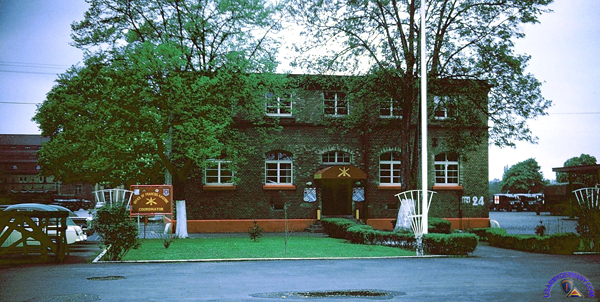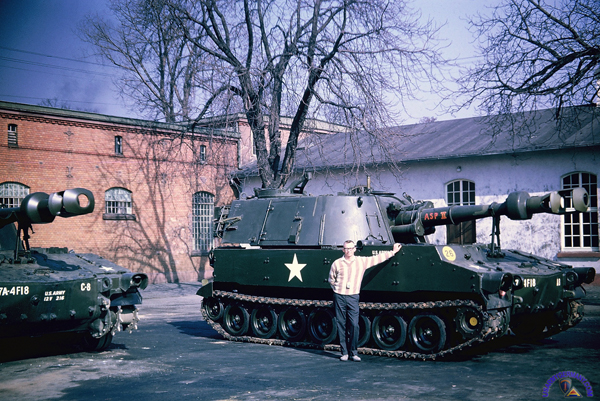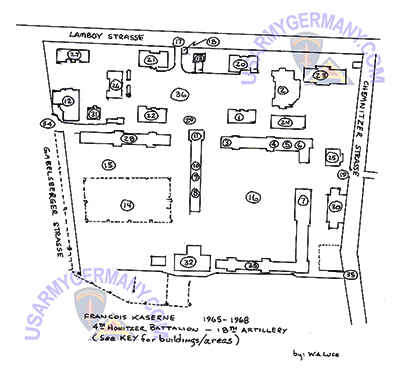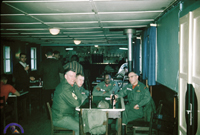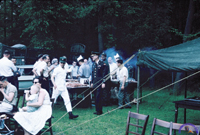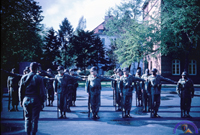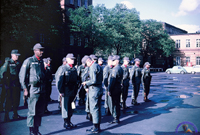| If you do
NOT see the Table of Contents frame to the left of this page, then Click here to open 'USArmyGermany' frameset |
||||||||||||||||||||||||||||||||||||||||||||||||||||||||
212th Field Artillery Group |
||||||||||||||||||||||||||||||||||||||||||||||||||||||||
|
|
||||||||||||||||||||||||||||||||||||||||||||||||||||||||
|
||||||||||||||||||||||||||||||||||||||||||||||||||||||||
|
|
||||||||||||||||||||||||||||||||||||||||||||||||||||||||
| SUBORDINATE UNITS | ||||||||||||||||||||||||||||||||||||||||||||||||||||||||
|
||||||||||||||||||||||||||||||||||||||||||||||||||||||||
| Group History | ||||||||||||||||||||||||||||||||||||||||||||||||||||||||
| 1958 - 1968 | ||||||||||||||||||||||||||||||||||||||||||||||||||||||||
| (Brief notes taken while doing research at the USAREUR Military History Office in the early 1980s; Letter, Subject: Order of Battle, United States Army, Europe, 20 October 1960) | ||||||||||||||||||||||||||||||||||||||||||||||||||||||||
 212th Field Artillery Group DUI 212th Field Artillery Group DUIOn 20 April 1946, after performing occupation duty in the US Zone of Germany, the 212th Artillery Group was inactivated in Germany. The group was reconstituted on 17 September 1958 and allotted to the Regular Army. The same order activated the group on 15 October 1958 in Hanau, Germany; the 212th FA Group was then further assigned to Seventh Army, and attached to V Corps. (Webmaster assumes that the Group took over the personnel and equipment of the concurrently inactivated 30th Field Artillery Group, whose mission it probably also assumed.) |
||||||||||||||||||||||||||||||||||||||||||||||||||||||||
ORGANIZATION (October 1960): [1]: |
||||||||||||||||||||||||||||||||||||||||||||||||||||||||
|
||||||||||||||||||||||||||||||||||||||||||||||||||||||||
|
ORGANIZATION (1 July 1966):
|
||||||||||||||||||||||||||||||||||||||||||||||||||||||||
|
||||||||||||||||||||||||||||||||||||||||||||||||||||||||
|
[1]
HQ USAREUR Letter, 20 October 1960, SUBJECT: Order of Battle, United States Army, Europe
[2] STATION LIST, 15 Dec 1965 |
||||||||||||||||||||||||||||||||||||||||||||||||||||||||
|
In
the fall of 1967, the group was designated to redeploy to CONUS under
project REFORGER.
On 9 April 1968, the group and its four subordinate field artillery battalions (2/18, 4/18, 2/34, and 2/37) departed Germany for its new home at Fort Lewis, Washington. 2nd Bn, 18th FA was equipped with the M110 eight-inch howitzers, the other three battalions had M109 (155mm) howitzers. All the units had left their equipment in storage in Germany as part of the REFORGER concept and had been issued brand-new equipment when they arrived at Fort Lewis. |
||||||||||||||||||||||||||||||||||||||||||||||||||||||||
|
Some
of the units that were at one time or another attached to the 212th
FA Gp in Germany:
|
||||||||||||||||||||||||||||||||||||||||||||||||||||||||
|
||||||||||||||||||||||||||||||||||||||||||||||||||||||||
(Source: STARS & STRIPES, Feb 24, 1968) |
||||||||||||||||||||||||||||||||||||||||||||||||||||||||
An advance party of 14 men of HHB, 212th Arty Group has been transferred to Fort Lewis, Wash., to help arrange for the group's redeployment of Group headquarters to this CONUS post. The main group will leave Germany in April of this year. The transfer of the 212th to the US is part of the redeployment of selected USAREUR units to the States under the REFORGER plan. In addition to HHB, two other units of the Group will be redeployed -- 2nd Bn, 18th Arty (Rothwesten Kaserne, Kassel) and 4th Bn, 18th Arty (Francois Kaserne, Hanau). |
||||||||||||||||||||||||||||||||||||||||||||||||||||||||
| If you have more
information on the history or organization of the 212th FA Group/Brigade
(or any of the subordinate units), please contact me |
||||||||||||||||||||||||||||||||||||||||||||||||||||||||
|
|
||||||||||||||||||||||||||||||||||||||||||||||||||||||||
| (Source: Author's collection) | ||||||||||||||||||||||||||||||||||||||||||||||||||||||||
| (Source: STARS & STRIPES, November 26, 1963) | ||||||||||||||||||||||||||||||||||||||||||||||||||||||||
|
||||||||||||||||||||||||||||||||||||||||||||||||||||||||
| Throughout USAREUR, servicemembers mourned the passing of President John F. Kennedy in November 1963. Here, the 212th Field Artilery Group at Fliegerhorst Kaserne fires a 21-gun salute using 105mm self propelled M-52's. |
||||||||||||||||||||||||||||||||||||||||||||||||||||||||
| (Source: Email from Charles COMMA Causey, First Vice President, 30th Field Artillery Regiment Association) | ||||||||||||||||||||||||||||||||||||||||||||||||||||||||
| The 212th did
take over the equipment and personnel of the 30th Field Artillery
Group. If you are ever in contact with any of the Honest John personnel who may have served in the 550th or 2/30th FA Honest John, please have them contact me or the web master at www.hardchargers.com. The same goes for all other FA personnel who served with any of the 30th units. Charles COMMA Causey |
||||||||||||||||||||||||||||||||||||||||||||||||||||||||
|
|
||||||||||||||||||||||||||||||||||||||||||||||||||||||||
| (Source: Email from Gaither Kitchell) | ||||||||||||||||||||||||||||||||||||||||||||||||||||||||
|
||||||||||||||||||||||||||||||||||||||||||||||||||||||||
|
|
||||||||||||||||||||||||||||||||||||||||||||||||||||||||
| 4th Howitzer Bn, 18th Field Artillery | ||||||||||||||||||||||||||||||||||||||||||||||||||||||||
 4th HOW Bn, 18th FA (SP) 4th HOW Bn, 18th FA (SP) |
||||||||||||||||||||||||||||||||||||||||||||||||||||||||
| 1963 | ||||||||||||||||||||||||||||||||||||||||||||||||||||||||
| (Source: Email from Charles Barrand) | ||||||||||||||||||||||||||||||||||||||||||||||||||||||||
| I served at Francois Kaserne, Hanau from Nov 1963 to 1966. Have the following information as it pertains to my time there (see installation map above):
Item 20 is "B" Battery I remember 3 Batteries not four. I do not remember an Item 23 Battery. I was in the 4th Battalion, 18th Artillery, 7th Army at the time. I was a sergeant E-5 Fire direction chief for Battery "A" 155 SP. My 1st Sgt was Sgt Brown, who was promoted to Sgt Major at battalion level in early 1966. I remember Lamboy Strasse with a little German sausage shop right across from the from gate Item 17. It cost 50 pfennigs (~12.5 cents then) for a grilled sausage and a piece of dark German bread. German mustard on the side. I do not remember the side strasses of Galelsberger and Chemnitzer, nor do I remember the gates Items 34 and 19. Item 12 was the Beer Hall on the second floor as I remember it. Don't remember Item 26, 27, 31, 29, etc. |
||||||||||||||||||||||||||||||||||||||||||||||||||||||||
| 1965 | ||||||||||||||||||||||||||||||||||||||||||||||||||||||||
| (Source: Email from Paul Buresh) | ||||||||||||||||||||||||||||||||||||||||||||||||||||||||
I served at the Francois Kaserne in Hanau from March 1965 to early February 1966. I worked in battalian HQ in the Message Center (in Security under S2, across the hallway).
Lt Col Lloyd A Corkan was Commanding Officer and Major Taylor was XO. I have a few photos of Francois Kaserne, as well as some of front gates of Yorkhof Kaserne, Hessen Homburg Kaserne and Flieglehorst Kaserns. All are from 1965. I was drafted in Feb of 1964, just 3 months after JFK was killed in Dallas. Inducted in Omaha, took tests both physically and mentally. Past both OK, went to Ft Leonard Wood, Missouri that night and arrived in the morning. In our loose formation in front of the barracks, my name and that of 6 or 7 others out of 250 was called. We qualified for Officer Candidate School (OCS) and, if we wanted to check it out, we could go to the office and find out more about OCS. I never went. It meant 1 or 2 years more to transfer to the school. I was already signed up for a 2-year gig. After Basic, went to Fort Sill, Oklahoma as a wireman, but became a radio operator. When the Sgt Major (at 4th Bn, 18th FA) was ready to assign me as a radio operator, I went over to the communications van and tried listening to 30 to 35 Words per minute. It was just too fast. I went back to the Sgt Major's office and he assigned me to security message center which was part of S2, Intelligence... |
||||||||||||||||||||||||||||||||||||||||||||||||||||||||
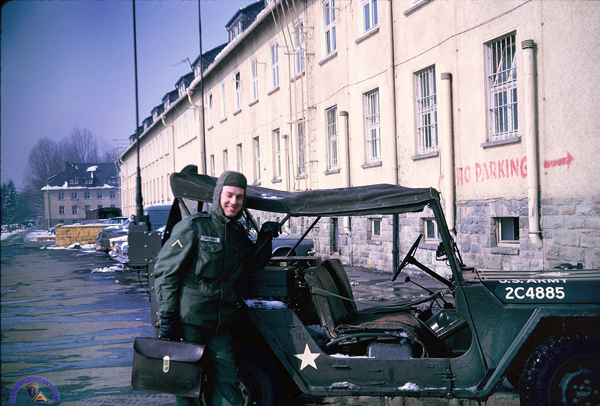 PFC Glen Williams on a message center run to Fliegerhorst Kaserne, Spring 1965 |
||||||||||||||||||||||||||||||||||||||||||||||||||||||||
There were four in our message center. We had 2 combination paddlocks: on our front door and, once in our office, we had 2 safes that we changed combinations to once a month. I had in my room 2 more combination padlocks: one for a foot locker and the other for a wall locker. So we all had to memorize 6 combinations. Sometimes I would go thru more than one set of numbers to get into something. In the city of Hanau, just 20 years after Hitler's war, some scars were showing on this old bombed out church. They left it that way to remember what they had gone thru. |
||||||||||||||||||||||||||||||||||||||||||||||||||||||||
|
||||||||||||||||||||||||||||||||||||||||||||||||||||||||
| 1st Missile Battalion, 32nd Artillery (HJ) | ||||||||||||||||||||||||||||||||||||||||||||||||||||||||
 The battalion sign when the unit was stationed at Yorkhof Kaserne |
||||||||||||||||||||||||||||||||||||||||||||||||||||||||
 A launcher unit of the 1-32nd Missile Battalion |
||||||||||||||||||||||||||||||||||||||||||||||||||||||||
 1st MSL Bn, 32nd FA (HJ) DUI 1st MSL Bn, 32nd FA (HJ) DUI |
||||||||||||||||||||||||||||||||||||||||||||||||||||||||
| (Source: Email from Paul E. Schaum) | ||||||||||||||||||||||||||||||||||||||||||||||||||||||||
| Ernst Ludwig Kaserne Looking at the photo of what was the main gate, the first building on the left housed a TAB (Target Acquisition Battery - I forget the unit designation). The next building housed HHB, 3d Bn 80 Arty, a Sergeant Missile Bn. The next building that you can't see because of tree growth, housed firing battaries of the same organization. The far end of the ELK housed maintenance buildings. On the far side of the facility on the other side of the parade field was a Hawk Air Defense Bn. and support to include Bn. medics. BTW, the Hawk Bn had a St. Bernard as a mascot and that dog sure got into a lot of mischief! Facing the parade field were the mess hall and other support for the organizations on post to include an education facility, e.g. teaching German, etc. and PX. Where the Sig Spt Bn mentioned by Nelson was located I would be interested to know. They were undoubtedly the guys with all the antennas at the corner of the Kaserne and supported the Hawk unit whose designation I can't recall. Sometimes one had enough to do to keep busy, especially with personnel shortages, that you had a hard time remembering your own unit designation . BTW, some of the interesting history of the post-war Kaserne was that it once housed the "Atomic Cannon." If you were in one of the top floor rooms of the buildings and you were having a good rain, looking out the window you would see "rectangular puddles." Warum? (Why?) It had an underground facility. I believe a German hospital unit was maintained there, but memory fails me if that was the type of unit. However, when the "Atomic Cannon" was there it was said that they actually kept "projectiles" there. There were tunnels that accessed the area but that were sealed off (at least to some degree). Perhaps only "C Co." was there and they kept a low profile, but my curiosity is a bit aroused. There are photos on another site taken by a fellow that I think was there before 1965, but I know that I was in HHB of the 3/80th during 1965-67. 1st Missile Battalion, 32nd Artillery This organization was an "Honest John" unit up to and sometime after 1965. Other web sites make this ommission as well. I provided the "Organization Day" folder for June, 1965 which included the units history and a photo (jpeg) of the unit crest as worn that day. Not long ago, the military history site took copies from me so they should be on record. The unit would be fully downloaded until an alert was called at which time you ran your butt all the way down to the motor pool to get all vehicles and launchers to the unit which was quartered just inside the Fliegerhorst gate on the left. Everything was uploaded and you floored it to Fulda Gap or other designated site. 3rd Missile Battalion, 80th Artillery I must comment that I was proud to be part of the 3/80th. It was the top ranked Sergeant Missile Bn in Germany at the time. I can tell you that one day during that period of time that suddenly there was a lot of running and hollering to turn off all signal equipment whether it be them or us. The "old horse" (stables) buildings that were used for maint. were working on expanding the area up in the attic. They broke through a wall and found a large quantity of HE (high explosives) plus things like detonator caps that could have been "energized" by the various antennas that were putting out plenty of RF energy. From what was said at the time, it would have been enough to "devastate (polite term)" ELK and some of its German neighbors. One can laugh about it now, but it wouldn't have been pretty for anyone. However, I recall a buddy and I walking across the parade field one day showing a new guy around the complex. There was a Bundeswehr ("Bundeswehr mit Sicherheit, JA") reserve outfit that kept one of their tanks on the Kaserne. The thing had a back fire that one can only imagine in an old military comedy movie. In any event, the new guy was walking and suddenly realized that he wass alone. He looked around and my buddy and I were flat on our faces "from good Army training." I have to look for a crest for the 3rd Bn, 80th Arty (Sergeant Missile) that was at Ernst Ludwig Kaserne, Darmstadt which once was home of the "Atomic Cannon." I had rooms on the top floor of HQ Btry and when it rained you could see rectangular puddles -- They had an underground medical unit there at one time, but also stored rounds for the 280 mm Canon as I learned later. (Fliegerhorst, Hanau, also had an underground air unit, but they were so well booby trapped that they finally just flooded the area / filled in.) BTW, a civilian train went trough the restricted storage area from time to time -- that is back to the 1/32 -- and they would open the fence gates at either end and we had to secure both sides of the track. The people were told not to get off the train and that it was better to keep the windows closed rather than risk getting shot. We did have nuke war heads for the Honest John -- Shhh! Back to the 3/80th in the 1960's. I wish I could remember the unit designation of the TAB Btry that was assigned, but they had the first building on the left of the gate as you came in. They had a bad reputation of not having members survive VN if they went. A Hawk Btry. was also moved into the Kaserne and the unit mascot was a St. Bernard that liked to come up behind guys during PT and if they moved, he growled. Strange dog. But, he wound up coming over and keeping our guards company while on duty which they appeciated having such a big dog as company. As you know, a Hawk outfit has a lot of radar, then there were a lot of signal equipment around the place too. One day runners came and told everyone to shut down the horizontal and vertical radars and all radio transmitters. At the far end of the Kaserne was what once was a stable converted into use by the motor maint. people. They were breaking through a wall in the attic and found a room full of WWII type explosives and det caps, etc. At any point in time engouh RF energy could have set the whole thing off. Estimations were that the Kaserne and the surrounding area would never have been the same. The 3/80th was the best Sergeant unit in Germany at the time! They did their yearly firing from the North Atlantic Missile Range on Benbecula, Outer Hebrides. The population ran flies, sheep, and then people. I still hate mutton because that's all they seemed to have. I ate a lot of candy out of the NAFI. The Brit C.O. had a lot of authority. One day he brought a village girl into the mess (they were susidizing people to stay there once TV got there and they realized there was more than peat and bog). The fishing, either in the small lakes (Benbecula was maybe 6 miles by 6 -- you can look up the islands online). There were no trees and when you got away from the village and off on your own or with a buddy, you suddenly realized that you could not only hear your breathing, but your heart beat as well. We fired the missile before the days of protective equipment, e.g. hearing protection. Here you were in a place where you could hear your heart beat, but when the missile went off (the non secure psi was 40K psi) you could see the lips of the guy next to you moving, but it sounded as if you were in a silent movie. It was not loud as in an 8" gun going off, it was so loud you felt as though you didn't hear a thing. That was were I learnd the meaning of "the sound was deafening." I wish I had save things at times. Then there were places you were and things you did that you wish you could just forget. |
||||||||||||||||||||||||||||||||||||||||||||||||||||||||
|
||||||||||||||||||||||||||||||||||||||||||||||||||||||||
| 2nd Gun Battalion, 38th Field Artillery (280mm) | ||||||||||||||||||||||||||||||||||||||||||||||||||||||||
| See more on the 216th FA Bn/2nd Gun Bn, 38th FA on the 36th FA Group Page | ||||||||||||||||||||||||||||||||||||||||||||||||||||||||
| (Source: Email from David Gilbert, Btry B, 2nd Gun Bn, 38th FA , 1960-63) | ||||||||||||||||||||||||||||||||||||||||||||||||||||||||
I served with the 2nd Gun Bn, 38th FA from Aug 1960 to Aug 1963. I was in the 2nd Gun Section, "B" Battery. Chief of the section was SFC Homer Pennington. Also, SSG Wilson ran the 1st Gun Sec. The Battalion was under the command of LTC Murphy at Ernst Ludwig Kaserne. Also on Ludwig was the 3rd of the 18th FA (8") and the 1st of the 21st FA (Honest John). On the web page was a guy by the name of Boyd who I remember. We did go to Graf for live fire and rolled a gun over in the off post firing position. I was also in Fulda when the wall went up in Berlin and we went on a high alert and had to stay on the guns. Also while at Graf, the 4th of the 18th FA (8") fired a round into Tent City and killed 17 men. The 18th was stationed in Hanau. The club on post was called the Red Scarf Club Monday -- nights were nickel beer night, the waitress was Elsie. The PX/Snackbar was located over the Mess Hall. A girl by the name of Big Magritte used to work there and she hung out at the Out Post down town Darmstadt and also at the Fisherstub, and Philips Bar. I do have an album of pictures from that time. I do remember a lot of the guys I was stationed with. I also put 20 years in the Army and went back to Germany on two more trips. I did go back to Ludwig -- the place had changed in 70, I went over to Little Moscow, the community outside the Caserne; the Budapest and they still served the best Schnitzels in Germany. It still had the same owners and they did remember me. I had a great time and we talked about the 38th. It's been a long time since I thought of the 38th. Maybe I jogged your memory. The 212th (FA Group) is no longer, it is now called V Corps Arty, consisting of 41st FA Gp and 42nd FA Gp. Most of the units are the same -- the 2/5th is 175mm; the 1/32nd is Lance Missle System. The 2nd/5th and the 3/18th and a TAB Btry are now stationed in Babenhausen. |
||||||||||||||||||||||||||||||||||||||||||||||||||||||||
|
||||||||||||||||||||||||||||||||||||||||||||||||||||||||
| (Source: Email from Frank Boyd) | ||||||||||||||||||||||||||||||||||||||||||||||||||||||||
|
||||||||||||||||||||||||||||||||||||||||||||||||||||||||
|
||||||||||||||||||||||||||||||||||||||||||||||||||||||||
| 1st Missile Battalion, 39th Field Artillery (CPL) | ||||||||||||||||||||||||||||||||||||||||||||||||||||||||
| (Source: Email from John Sullivan) | ||||||||||||||||||||||||||||||||||||||||||||||||||||||||
| Just a little info for you I could not find on this site. I was with the 1st of the 39th FA stationed in Fliegerhorst Kaserne, Hanau. The Corporal missle was our weapon. This was also the kaserne where Pres. Kennedy stopped at before going on to Frankfurt and Berlin. If you have any info about this outfit and where, or when it moved to after March 1963, I would appreciate it. The only thing I can add is that the Corporal missiles we had were fired in the Hebrides Islands off of Scotland. When I left Fliegerhorst in March of 1964, I did not know of any deactivation in the works although I was not in a position to know of such things. There was not even a rumor going around. My most memorable experience was working in the operations for Pres. Kennedy (SPECIAL VISIT) in June 1963. We worked in the (Fliegerhorst Airfield) tower, and I was the only enlisted man in the whole group. Most of the time people would have not known that, because a lot of times we worked on the phones etc. with our shirts off. The night before Pres. Kennedy arrived we stayed in the tower and slept on cots brought in. When Kennedy arrived I had the pleasure of sitting directly behind him about 15 ft as he stood on the podium addressing the troops. All of us who worked in operations for his visit were given white tickets which enable us to sit there. I can't remember exactly how many of us work in the operations room in the tower, but it was about eight or nine. There were of course others who worked on this operations from all over Germany, but ours was the nucleus point. Col. Mulcahy was in charge of operations (not sure of spelling for his name). Security was very tight, and I remember one day a major in charge of transportation for this operation, but not from our post, could not get through the front gate without the UP's calling us first. A few troops that were stationed at Fliegerhorst were given three day passes, and made to leave the post the day before Kennedy arrived (security?) even though German civilians were allowed on the day he arrived. Secret service people were there days before he arrived. When he arrived the secret service watched very closely the people with cameras, and I saw them remove camera tripods that people had set up. I knew Kennedy's schedule, and after he gave the speech to the troops he was going to a luncheon on post. I hurried over there and was first at the door standing next to the sidewalk. Pres. Kennedy walked from the podium over to the luncheon building and started shaking hands with the crowd about 30 ft from the door. Wouldn't you know it, he stopped his handshaking two people from me and walked in the door. Col. Bullard was director of port operations in Bremerhaven, and was directly in charge of shipping the new 175s to us for Kennedy's display even though the troops for these new arty. guns were not to arrive in Germany from Ft. Sill for another three months or so. All in all a great experience. |
||||||||||||||||||||||||||||||||||||||||||||||||||||||||
| 2nd Battalion, 75th Field Artillery (8 in How)(SP) | ||||||||||||||||||||||||||||||||||||||||||||||||||||||||
 2nd Bn, 75th Arty DUI 2nd Bn, 75th Arty DUI |
||||||||||||||||||||||||||||||||||||||||||||||||||||||||
| For more on the early days of 2nd HOW Bn, 75th Arty -- see the 30th FA Group Page. | ||||||||||||||||||||||||||||||||||||||||||||||||||||||||
| 212th Field Artillery Group | ||||||||||||||||||||||||||||||||||||||||||||||||||||||||
| 1959 | ||||||||||||||||||||||||||||||||||||||||||||||||||||||||
| (Source: Email from Lee Davis, 2nd How Bn, 75th FA and HHB, 212th FA Gp, 1959-61) | ||||||||||||||||||||||||||||||||||||||||||||||||||||||||
| I was stationed at Fliegerhorst from Aug. 1959 to Feb. 1961.....75th Field Artillery. I joined the Army on March 9, 1959...took basic at Ft. Leonard Wood, & Ft. Riley, then on to Ft. Chaffee for 105 training and truck driver. I was sent to Germany on a very slow boat (might have been the Geiger...but that might have been the return trip) and we were put on a train at Bremerhaven and went to Hanau. then on to the back of duece-and -a halfs to Fliegerhorst.
Upon arriving we were sitting in front of headquarters, 2nd How. Btn, 75th Arty and a PFC came out and asked which one of us was from St. Charles (Ill.) I replied I was and he shook my hand, introduced himself as being from Aurora, and asked what my MOS was. When I told him he said I was going to be doing "the cannoner's hop" for the rest of my time in Germany. Not knowing what that meant, I asked him to explain and he drew the sobering picture of taking the 8 inch towed guns to the field every two weeks or so, living in tents, etc.,etc. He then asked if I had typing in high school and I said yes....I was just 18. So he said they had an opening in personnel coming up and he would put in a word to Mr. Price, the W.O. if I would like him to...Of course I said sure, and I became Officer's Record's Clerk. That lasted about 3 months when Col Byrd (no kidding) sent word around the post he would like to start a band, so I voluntered for that, and on Jan 1, 1960 was put on TDY to the gym to be a part of the 212th Artillery Group Band. We had a very good small band (about 20 to 25) and started playing for Fasching parades as a good will gesture. It was really great duty and we got to go to a lot of small burgs and drink with the comrades after the parade.....but in October a new Colonel came in and broke the band up. We were all sent back to our home units, and they were laying for us. I had guard duty about every 5 days in addition to my day job (court martial clerk back in Personnel) and I made a short timer's calendar and crossed each day off with anticipation. It finally ended in early February 1961 when I rotated back ...but I have a lot of fond memories and even went back to visit in Dec., 2001. |
||||||||||||||||||||||||||||||||||||||||||||||||||||||||
|
||||||||||||||||||||||||||||||||||||||||||||||||||||||||
|
||||||||||||||||||||||||||||||||||||||||||||||||||||||||
|
||||||||||||||||||||||||||||||||||||||||||||||||||||||||
| 1962 | ||||||||||||||||||||||||||||||||||||||||||||||||||||||||
| (Source: Email from James "SAM" Huff, 2nd Bn, 75th Arty, 1962-64) | ||||||||||||||||||||||||||||||||||||||||||||||||||||||||
|
||||||||||||||||||||||||||||||||||||||||||||||||||||||||
|
||||||||||||||||||||||||||||||||||||||||||||||||||||||||
|
||||||||||||||||||||||||||||||||||||||||||||||||||||||||
| 36th Field Artillery Group | ||||||||||||||||||||||||||||||||||||||||||||||||||||||||
| 1970 | ||||||||||||||||||||||||||||||||||||||||||||||||||||||||
| (Source: Email from James Cramp) | ||||||||||||||||||||||||||||||||||||||||||||||||||||||||
| I was in C Btry, 2nd Battalion, 75th Artillery, 36th Field Artillery Group from 1970 to 1972. This was an 8th inch howitzer battalion. It was commanded by Lieutenant Colonel Issac Smith during this entire period. We were stationed at Fleigerhorst Kassern near Hanau. C Battery commander was Captain Daniel E. Hudson until December 1971. We had M110 self propelled 8-inch howitzers. I came to C Battery 2nd Bn, 75th FA in November 1970 directly from Fort Sill Fire Direction Control training school. When I got to the Battalion they had 4 FADAC computers (one for each firing battery and one for battalion FDC). Absolutely nobody in the battalion knew how to operate the computers except for one classmate from Fort Sill who arrived in the battalion the same time as I did and was assigned to B Battery. In January 1971 we went to Grafenwoehr for training. It was the worst month of my life. Always cold and one less than hot shower in a month. The first day at Grafenwoehr an order came down from battalion that we could train with the FADAC computers, but couldn't use the firing data for the howitzers. The actual firing data would be done manually with the pins, map table and hand calculations. I went to my CO, Captain Daniel E Hudson to protest this policy. He said he couldn't do anything because the order came from Battalion. I asked to present my case to Lt-Colonel Issac C. Smith and was allowed to do so. I told Colonel Smith that the Army didn't spend $40,000 on each of the FADAC computers to have them sidelined, that I was competent on its operation and that if he let me use the computer, I guaranteed that I would outshoot the other two firing batteries. This from a SP-4 with two weeks time in grade. He allowed me to use the FADAC for actual firing data. I outshot the other two batteries so badly it was not a contest. When we got back to base I was put in charge of training all the battalion and battery FDC's on using the computers and we never went back to manual FDC. On my last trip to Grafenwoehr, C Battery with myself operating the FADAC computer put first round on target 15 of 16 times during testing. The chief umpire said that he had tested every artillery battery in V Corps and VII corps and that we were the best battery that he had ever tested. I got an Army Commendation medal for that performance. I didn't especially care for my Army experience at the time. My major issue was that I had a BS in mechanical engineering and a good job at the time and it was costing me earnings and career advancement. Looking back the actual experience wasn't bad and I wouldn't give it up. ADDITIONAL INFORMATION I should also add that in 1970, I was making approximately $200/month as a SP 4 with zero years in service. I was told that the FADAC computers cost $40,000 each at a time when you could buy a pretty nice house for $25,000. One operator and a FADAC computer would replace 4 soldiers. The problems with the FADAC were that it weighed 200 pounds and needed a temperamental gasoline generator to operate. You still needed the backup manual operators. |
||||||||||||||||||||||||||||||||||||||||||||||||||||||||
|
|
||||||||||||||||||||||||||||||||||||||||||||||||||||||||
| Related Links: 212th Field Artillery Brigade Dead Link - official website of the active brigade |
||||||||||||||||||||||||||||||||||||||||||||||||||||||||











